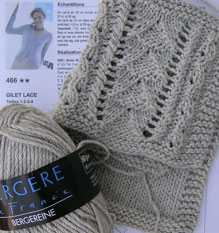 The flip side is done. Sleeves will be cast on today after a bit of head scratching yesterday.
The flip side is done. Sleeves will be cast on today after a bit of head scratching yesterday.
We’ve learned how to calculate increases from the wrist to the underarm – that’s no problem. We’ve learned how to sew seams between stockinette stitches. What I don’t quite get is how to handle increases when using a stitch pattern. Is the edge stitch still done in stockinette? What happens if the increase stitch falls in an awkward place in the pattern stitch? Mine has some twisted stitches.
Not quite sure about these questions. I’ll just cast on and give it a shot. After all, I can always rip it out later.
Over the Christmas holidays several family members asked about the red string at the bottom. I thought I’d mention it in case others might wonder. It’s a provisional cast on. When the top half is finished I’ll pull out the red string and put these stitches on a needle and then work the ribbing from there down. So, no, the red string is not part of the design.

And for something different …
…. Campion / Spindrift trivia
There’s not just one autumn.
To the right (in the hank) is autumn #5. Perhaps the original autumn?
Top left is autumn #261. One that is found on many AS color cards.
Bottom left is autumn #1100. Looks a lot like the Shetland Heathered Aran color called hairst. If only it was produced in Spindrift as well. What a lovely complex color. Hairst is another word for autumn (according to the Shetland Museum’s website).

 Gosh, when I first saw this yarn on Anni’s blog,
Gosh, when I first saw this yarn on Anni’s blog, 
 Can you guess which part of this swatch is handspun and which is not?
Can you guess which part of this swatch is handspun and which is not? My first unwashed swatch was done on with size 3.25mm needles, and produced a slightly stiff and uneven fabric. The stitches became tighter and more even when I switched to 3.0mm needles. Perhaps the stitches would look better after washing but I haven’t had a chance to do a wash test. As you can tell, I’m not too impressed with this yarn. Chances are that it will become a lonely ball at the bottom of my knitting basket reserved as a good point of reference.
My first unwashed swatch was done on with size 3.25mm needles, and produced a slightly stiff and uneven fabric. The stitches became tighter and more even when I switched to 3.0mm needles. Perhaps the stitches would look better after washing but I haven’t had a chance to do a wash test. As you can tell, I’m not too impressed with this yarn. Chances are that it will become a lonely ball at the bottom of my knitting basket reserved as a good point of reference.
